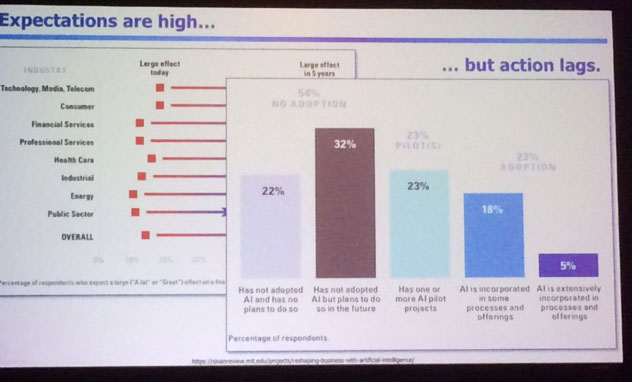Is the Tipping Point for AI Here?
Artificial intelligence (AI) is poised to change how we work, play, and live, but it may not change things nearly as quickly or as impressively as today’s hype claims it will. In the words of Gary Marcus, commented during the Open Data Science Conference, “We wanted Rosie the Robot and we got the hockey puck Roomba.” The reality is that AI, machine learning (ML), and deep learning (DL) capabilities today lie somewhere in the middle.
The hype around AI is nothing new; in fact, this is actually just the latest wave of the “AI will solve/change everything” excitement. From Alan Turing and his 1950 paper, “Computing Machinery and Intelligence,” to AI flourishing from 1957 to 1974, to resurgences in the 1980s, 1990s, and 2000s. Clearly there’s been no lack of interest, expectation, and promotion around the promises and potential of AI. The pitfalls have been in the expense, processing power, and context for AI to become a reality.
The first question we should ask is: are we finally at the tipping point for AI and machine learning? According to Erik Brynjolfsson and Andrew McAfee, of MIT’s Initiative on the Digital Economy and co-authors of Race Against the Machine, The Second Machine Age, and Harnessing our Digital Future: Machine Platform Crowd, in Harvard Business Review’s article, “The Business of Artificial Intelligence,” the “biggest advances [in AI] have been in two broad areas: perception and cognition.” Our new voice assistant friends, Siri, Alexa, and Google Assistant have made significant progress in speed and in reducing errors – all since the summer of 2016. AI proponents point to several other reasons why AI will be truly successful this time; those reasons include the scale of computer, better infrastructure, and more and better investment in the technologies.
Sam Ransbotham, guest editor of MIT Sloan Management Review and associate professor at Boston College’s Carroll School of Management, shared some statistics on AI and machine learning in his presentation, “The Adoption of AI in Business: Opportunities and Challenges.” According to Ransbotham, an annual survey on the use of AI and analytics found that only 5% of organizations have extensively incorporated AI into their business, with 77% reporting they are not really doing anything with AI yet. Those that have started down the path of AI are doing so to reduce costs, become more competitive, enter new markets and respond to customer demand.

The second question to ask is why a business might want or need AI. As Brynjolfsson and McAfee state, “AI has generated lots of unrealistic expectations. We see business plans liberally sprinkled with references to machine learning, neural nets, and other forms of the technology, with little connection to its real capabilities. Simply calling a dating site ‘AI-powered,’ for example, doesn’t make it any more effective, but it might help with fundraising.”
Not every business should jump on the AI bandwagon. An organization needs to consider its data. As Alex “Sandy” Pentland pointed out during his keynote presentation, “Blockchain AI, or Future Data Systems Must be Built Differently,” “AI eats data.” You need a treasure trove of historical information in order to build your AI or ML models. You also need continuous operational data to “feed” your AI system; machine learning, by definition, “learns” along the way. For example, imagine you are a consumer product goods (CPG) company that wants to use machine learning in order to predict which new products currently being considered would have the biggest chance of being successful in the marketplace. And, then you might want to ask your machine learning solution to tell you which customers the product will be successful with. To get these answers, you need volumes of historical data on your products, associated sales numbers (including projections and actuals), customer data, and more. Then you need to provide the system with continual real-time (or, near real-time) operating data on what is happening today. Let’s say our CPG company is a health/wellness/beauty company. It’s most popular products several years ago included various acids and chemicals for different results. But today’s trends are to bring in all-natural products when possible and use functional ingredients. Machine learning needs both historical data and current data to make accurate predictions.
Ransbotham also mentioned that most current examples of AI are not in production-ready environments or are not yet scalable. On the other hand, many speakers at the conference cited how AI and machine learning are being used in organizations today. Those examples include the Orion spacecraft mission, a DARPA project using Natural Language Processing (NLP) to predict suicide risk, identifying fraudulent merchants making credit card transactions, and optimizing mineral extraction in the mining industry. Clearly AI can be applied to a wide range of industries and applications.
AI holds many promises. But organizations who are considering turning to AI and machine learning need to be clear-eyed about what it can and can’t bring to the business. AI might become a game-changer for some organizations, but it won’t be one for all the businesses rushing to add “AI” to their portfolios.